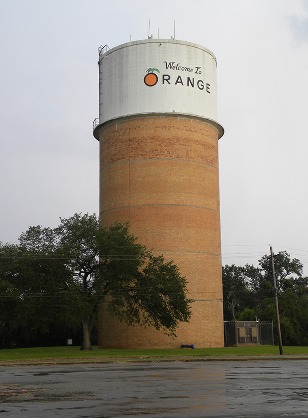Orange, Texas gulf coast, Orange County seat. (original) (raw)
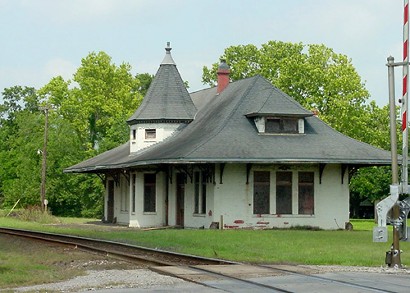
The former depot in Orange
TE Photo, 2003
Orange, is considered a point of what is known as the "Golden Triangle" - the other points being Port Arthur and Beaumont
History in a Seashell
Orange had several names before 1858 - the year it officially became Orange. Originally called Green's Bluff after an early Sabine River boatman, it was renamed Madison in 1840, but it sometimes delayed mail - which was sent to Madisonville (Madison County) in error.
The town's post office was granted in 1850 and two years later, Orange County was organized with Madison as county seat.
The final name change took place in 1858 when it finally became Orange - to the great relief of postmasters and the mail-receiving public.
The name reportedly comes from a local orange grove owned by a man named George Patillo.
Outlaws used Orange as a temporary residence while they waited for the heat to cool down in Louisiana. The town became a major port on the Sabine from the 1840s through the 1890s.
The railroad (Texas and New Orleans) arrived in 1860, but service was disrupted when the rails were torn up during the Civil War. After the war the town was occupied by troops from Illinois.
At the peak of East Texas lumber production, Orange was the center of the Texas lumber industry - having seventeen sawmills within the city limits. It was Orange's zenith.
A timeline of selected or significant events in Orange's history
1897: The Kansas City Southern Railroad reaches Orange
1902: Six large lumber companies acquire ownership of 17 smaller lumber mills
1914: Population reaches 7,000
1916: Port dredged - making Orange a deep water facility.
WWI: Orange serves as a major shipbuilding center for both world wars
1920s: East Orange becomes famous for its 1920s nightclubs - crime rampant between wars.
1938: Rainbow Bridge opened across the Neches River between Orange and Port Arthur.
WWII: Shipyards increase population to 60,000 people. After the war, ships were mothballed on the Sabine River and the population decreases to a manageable 21,100 in 1950.
In August, 2000 the USS Orleck, after having served in the Turkish Coast Guard returned to the port where she was built in 1945.
"A brick-based water tower.
You need this for your collection."
- Bob Finch, Ed.D., August 2010 photo
Historical Marker - on 803 W. Green Ave.
ORANGE
The first known settlers in what is now the city of Orange were John and Elizabeth Harmon, who arrived in 1828 with their three children. Known first as Green's Bluff, the small farming community that developed along a bend in the Sabine River was selected as the seat of government when Orange County was created in 1852. The town was called Madison from 1852 until 1858, when the name Orange was adopted.
The early Orange economy was based on the lumber and shipbuilding industries. Led by prominent pioneer area lumbermen and aided by the advent of the Texas and New Orleans Railroad in 1876, Orange was recognized as the leader in East Texas sawmill activity by the 1880s. The deep water port and the availability of lumber made the city an ideal location for the shipbuilding industry, which reached its highest production levels during World Wars I and II.
For many years the city of Orange has maintained a full range of services for its citizens. Public schools have operated since the 1880s and electricity was instituted in 1890. Orange's shipbuilding and petrochemical industries continue to make the city a leading commercial center in southeast Texas.
Orange, Texas
Attractions / Landmarks:
The Hanging Tree of Orange Texas
by W. T. Block ("Cannonball's Tales")
Cross-cut Saw Thwarted Judge Lynch
"On the afternoon of July 7, 1892, two men wielding a cross-cut saw hurried to fell the mighty pin oak tree which shaded the front entrance of D. Call and Sons Grocery at Fourth and Front Streets, on the waterfront at Orange, Texas." more
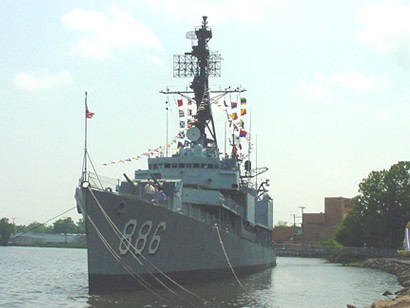
U.S.S. Orleck - On Front Avenue on the water
TE Photo, 2003
Historical Marker - Front Ave. and 3rd St. U. S. S. Aulick [sic]
On September 9, 1940, a federal contract worth $82 million was issued to the Consolidated Steel Company to construct 12 Fletcher class naval destroyers here in Orange, Texas. This and other contracts coupled with the subsequent building of major shipyard facilities along the city's riverfront lifted the city out of a prolonged and deep economic decline which began in the early 1930s with the closing of area sawmills. The community celebrated the laying of the keels of the U. S. S. Aulick [sic] and U. S. S. Charles Ausburne on May 14, 1941. The Aulick [sic] became the first naval destroyer to be built in Texas and on Texas Independence Day, March 2, 1942, it was christened and launched amid a crowd of 6,000 people.
The Aulick [sic] represented the second U. S. Naval warship to be named after War of 1812 Navy veteran John H. Aulick [sic] (1787-1861). By 1946 all 12 destroyers and over four hundred other ships had been completed here at a cost of over $876 million. Orange's well-developed shipyards encouraged major companies to build plants along the riverfront. Several petrochemical and industrial concerns followed suit in the 1950s and 1960s. Wartime shipyards operated by Consolidated, Levingston, and Weaver converted to peacetime activities.
1993
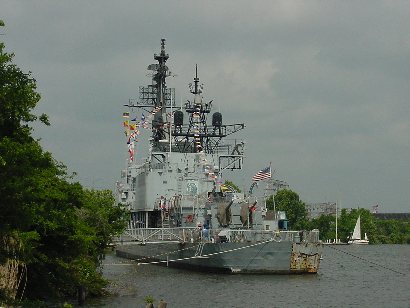
Back view of U.S.S. Orleck
TE photo 2003
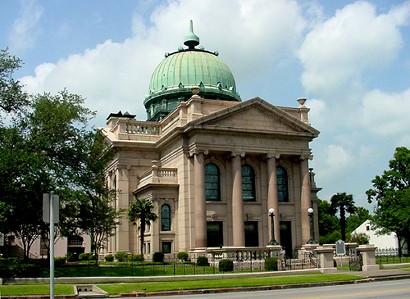
First Presbyterian Church - Lutcher Memorial Building
902 W. Green Avenue
Recorded Texas Historic Landmark
TE Photo, 2003
More Texas Churches
Historical Marker
Lutcher Memorial Church Building
Founded in 1878, the First Presbyterian Church initially occupied a frame structure built in 1883 at Market and Polk Street. In 1912 the congregation moved to this church building which Frances Ann (Mrs. Henry Jacob) Lutcher (1841-1924) had erected as a gift from the Lutcher family. H. J. Lutcher (1836-1912) amassed a fortune in the Lutcher & Moore Lumber Company. The Lutchers and their two daughters Carrie (Mrs. E. W.) Brown and Miriam (Mrs. William H.) Stark were philanthropists and community leaders. Mrs. Lutcher asked that the cost of the building never be publicized. She and her descendants set up a permanent endowment to maintain the facility. Fine workmanship and materials appear throughout the structure. The beautiful art glass windows were made by Lamb Studios of New York. For the upper foyer, Mrs. Lutcher chose three prize-winning windows from the 1893 Chicago World's Fair. The marble came from Italy and the granite was shipped by rail from Llano, Texas. The dome is topped by a copper cupola. Decorations on the sanctuary ceiling and walls have gold leaf overlay. The pews and wood paneling in the organ loft are mahogany. Mosaic work adorns the pulpit, marble communion table and baptismal font.
Recorded Texas Historic Landmark - 1978
Cartoon by Roger T. Moore:
1912: the First Presbyterian Church of Orange is the worlds' 1st public air-conditioned building.

W. H. Stark House c. 1894 - 610 West Main Street
Recorded Texas Historic Landmark
TE Photo, 2003
More Texas Historic Homes
Historical Marker
W. H. Stark House
Eastlake detailing decorates the porches and gables of this ornate Queen Anne style residence, built in 1893-94 for William Henry (1851-1936) and Miriam (Lutcher) (1859-1936) Stark. A financial and industrial pioneer, Stark headed several lumber and petroleum companies. His son H. J. Lutcher Stark (1887-1965) was noted for his cultural and educational philanthropies. Both men served as regents of the University of Texas. The Nelda C. and H. J. Lutcher Stark Foundation restored the house.
Recorded Texas Historic Landmark - 1976
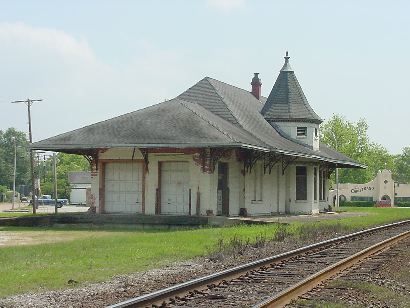
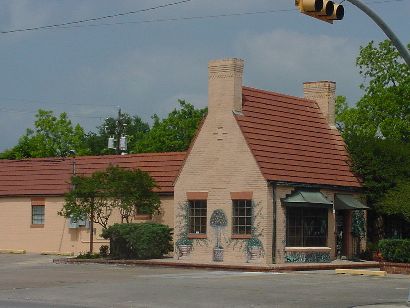
Orange Chamber Commerce
TE photo, 2003
Orange, Texas Chronicles
- The not-so-aptly named steamship War Mystery
by Mike Cox
"The East Texas-built steamship War Mystery qualifies as one of the least-aptly named vessels in maritime history.
That�s because there wasn�t a darn thing mysterious � and certainly nothing secret � about this giant World War One-era, yellow pine steamship built in Orange in 1917-1918... " more
Orange Tourist Information
Orange Convention & Visitors Bureau
803 W. Green Avenue Orange, Texas 77631-0520
P.O. Box 520 Orange, Texas 77630
409-883-1011 or 1-800-528-4906
http://www.org-tx.com/chamber/
Book Hotel Here > Orange Hotels
Texas Escapes, in its purpose to preserve historic, endangered and vanishing Texas, asks that anyone wishing to share their local history, stories, landmarks and recent or vintage photos, please contact us.
